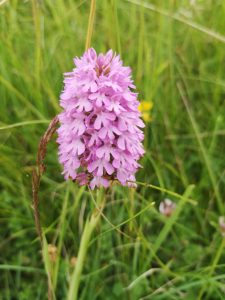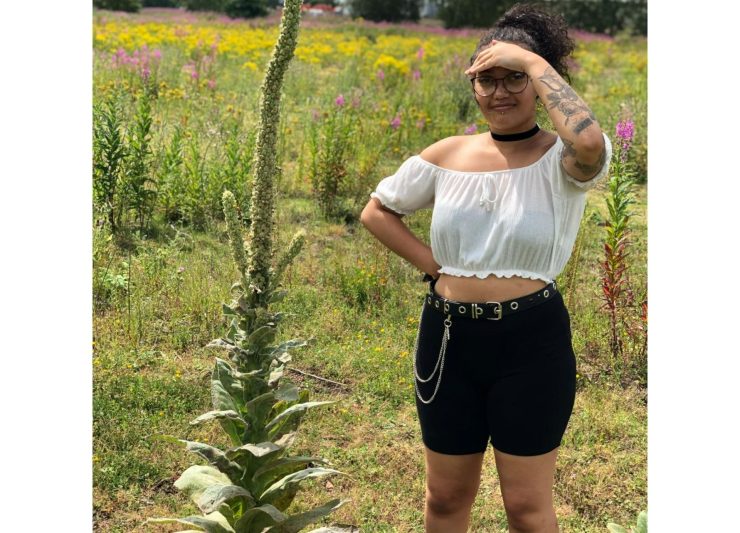About me
If you’ve found your way to this blog, I can only assume but also hope that you have somewhat of an interest in plants, even if that interest is but a seed for now. To you, I introduce myself as Charlotte Williams, a 2nd year student studying Ecology and Conservation with an unstoppable passion for plants.
I chose to come and study at the University of Brighton as I was seeking a city that would accept me, where I wouldn’t be stared at and seen as an oddity for expressing myself! While I was certain about the city I wanted to study in, I wasn’t set on the degree until I found the ecology and conservation course here. I felt this course would be perfect for me due to the sheer variety of topics being taught; I knew I would be able to find my calling here. Towards the end of my first year of study, I found it, my muse if you will, in plants. While studying for a module called Diversity of Organisms, which funnily enough focused on the diversity seen in living organisms, I learnt a fact that opened my eyes to the wonder of plants. You may be wondering what that fact was, and while it may be anti-climactic to some, I was in awe of the idea that there are flowering plants (angiosperms) and non-flowering plants (gymnosperms and bryophytes) on this earth. This may seem to be a relatively simple and inconspicuous point, but to me, it unveiled the diversity that exists in the evolution of the plant kingdom and scratched an itch I didn’t know I had by categorising these ideas under interesting sounding words. From here, my love of plants bloomed.




Images left to right: Great Willowherb (Epilobium hirsutum) being pollinated by a bumble bee (Bombuus sp.) at Falmer campus. Rose of Sharon (Hypericum calycinum) at Grand Parade campus, Spear thistle (Cirsium vulgare) at Falmer campus. Pyramidal Orchid (Anacamptis pyramidalis) at Moulsecoomb campus
About the placement and why it’s useful experience
Through Maureen Berg, my course leader and the resident plant ecologist at the university, I learned that a summer placement opportunity to survey the plant biodiversity on our campuses was available. This, of course, piqued my interest as it’s been a long-time goal of mine to be able to point to every plant I see and identify it to my friends. While I was successfully chosen out of a line-up of prospective surveyor students, for some reason, few people are willing to stop every couple of minutes while walking to look at plants! These few people, though, will certainly be friends for life after surviving the trial of attention span that is me talking about the identifying characteristics of grasses.
According to my master plan, I utilised this placement as a practical opportunity to improve my plant-identifying skills. This was a huge success, as I can now bother my friends much more frequently and with heightened accuracy, much to the dismay of the friends themselves. These developed identification skills have made me all the more powerful, my parents fear I may soon be unstoppable… and they could be right! Once I finish my degree, these identification skills along with gained survey experience will be invaluable in developing my career as an aspiring plant ecologist and improving my employability. Thinking in the closer future, these skills that I’m building upon will give me a head start in volunteering opportunities that could involve plant surveying and have drastically improved my confidence in my ability to take on such roles. For example, I recently took part in a BioBlitz at Seven Sisters South Downs National Park, an avenue I would not have felt comfortable exploring even a couple of months ago.
Actually about the placement
Now, you’re probably asking yourself what it is I actually did for this summer placement, and if so, I’m glad my suspense-building has worked. Over the course of a few weeks, I visited the three university campuses in Falmer, Moulsecoomb, and Grande Parade. For my surveys, I walked around these sites with many an ID guide in tow to try to identify all of the plants that were present. In addition to the identification of species, I also identified the type of habitat present in each area and marked this on a map. With a dash of software magic and a sprinkle of laptop crashes, I brought together the areas of different habitat types in ArcGIS to create a scale map of the habitats found on each of our campuses. The ArcGIS software also allowed me to calculate some descriptive statistics about the habitats I found, for example, I could objectively assess which habitat type is most prevalent across the three campuses by comparing the combined areas and perimeters. For those who are curious, the most widespread habitat type was amenity grassland, which essentially describes an area of grass that is mown incredibly short for recreational activities. You’ll often see this on sports fields; the only plants that can survive the harsh mowing and foot traffic here to peak out above the grass are the real tough cookies like daisy (Bellis perennis), plantain species (Plantago sp.) and white clover (Trifolium repens). These plants eat nails for breakfast, with no milk.
At the time, the green area at Moulsecoomb place was also on my list to survey, but unfortunately, it was sold to a group outside of the university just after I finished my surveys there. Evidently, I was cruel to others in my past life to deserve this misfortune. As for the other sites, I managed to retain some luck in the form of orchid discoveries! While completing surveys with Maureen towards the back of the Moulsecoomb campus, we spotted a couple of bee orchids (Ophrys apifera) along with an unexpected population of pyramidal orchids (Anacamptis pyramidalis). Gorgeous wildflowers are always exciting to find, but even more so when they’re right on your doorstep like these!




Image left to right: Dwarf thistle (Cirsium acaule) at Falmer campus, Square-stalked Willowherb (Epilobium tetragonum) at Falmer campus, Yarrow (Achillea millefolium) with pink flowers instead of usual white at Falmer camps, Square-stalked Willowherb (Epilobium tetragonum) at Falmer campus.

Published by